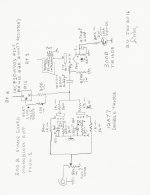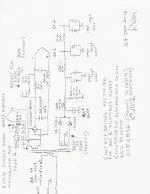Many good 300B amplifiers do Not use negative feedback (not Global, and not Local).
Many good 300B amplifiers Do use negative feedback (Global, or Local, or Both).
A question for all of you to think about:
Is the need for negative feedback to fix the first/driver stages distortion; or is it to fix the 300B distortion; or both?
I built a number of different Single Ended 300B amplifier circuits.
I never used global negative feedback, and I never used local negative feedback on any of those circuits. They were all 2 stage amplifiers, some used interstage transformer, some used RC coupling.
I enjoyed listening to all of those amplifiers.
Just my personal experience.
Much of how a 300B amplifier performs and sounds depends on:
1. The quiescent voltage and current of the 300B
2. The output transformer primary impedance
The combination of 1. and 2.
3. The dynamic range and distortion levels of the previous stage(s) that drives the 300B.
4. The signal voltage to the amplifier (lots from a CD player, sometimes lower level from a phono preamp).
5. If you have low signal voltages, you may need 3 stages; if you use negative feedback you may need 3 stages;
If you use a CD player and no negative feedback, you should only need 2 stages.
6. Your loudspeakers. Sensitivity; Impedance versus frequency.
7. Your room size and reflectivity/deadness, how loud you like to listen, what kind of music.
8. Near-field listening such as at the computer desk, or far-field such as out in the living room.
Try a proven 300B amplifier. You may like it, but it may not be your last 300B circuit.
That can be good or bad, depending on your budget, and how you look at it.
Have Fun!
Many good 300B amplifiers Do use negative feedback (Global, or Local, or Both).
A question for all of you to think about:
Is the need for negative feedback to fix the first/driver stages distortion; or is it to fix the 300B distortion; or both?
I built a number of different Single Ended 300B amplifier circuits.
I never used global negative feedback, and I never used local negative feedback on any of those circuits. They were all 2 stage amplifiers, some used interstage transformer, some used RC coupling.
I enjoyed listening to all of those amplifiers.
Just my personal experience.
Much of how a 300B amplifier performs and sounds depends on:
1. The quiescent voltage and current of the 300B
2. The output transformer primary impedance
The combination of 1. and 2.
3. The dynamic range and distortion levels of the previous stage(s) that drives the 300B.
4. The signal voltage to the amplifier (lots from a CD player, sometimes lower level from a phono preamp).
5. If you have low signal voltages, you may need 3 stages; if you use negative feedback you may need 3 stages;
If you use a CD player and no negative feedback, you should only need 2 stages.
6. Your loudspeakers. Sensitivity; Impedance versus frequency.
7. Your room size and reflectivity/deadness, how loud you like to listen, what kind of music.
8. Near-field listening such as at the computer desk, or far-field such as out in the living room.
Try a proven 300B amplifier. You may like it, but it may not be your last 300B circuit.
That can be good or bad, depending on your budget, and how you look at it.
Have Fun!
Last edited:
i do appreciate your statements, but have some questions:Many good 300B amplifiers do Not use negative feedback (not Global, and not Local).
Many good 300B amplifiers Do use negative feedback (Global, or Local, or Both).
A question for all of you to think about:
Is the need for negative feedback to fix the first/driver stages distortion; or is it to fix the 300B distortion; or both?
I built a number of different Single Ended 300B amplifier circuits.
I never used global negative feedback, and I never used local negative feedback on any of those circuits. They were all 2 stage amplifiers, some used interstage transformer, some used RC coupling.
I enjoyed listening to all of those amplifiers.
Just my personal experience.
Much of how a 300B amplifier performs and sounds depends on:
1. The quiescent voltage and current of the 300B
2. The output transformer primary impedance
The combination of 1. and 2.
3. The dynamic range and distortion levels of the previous stage(s) that drives the 300B.
4. The signal voltage to the amplifier (lots from a CD player, sometimes lower level from a phono preamp).
5. If you have low signal voltages, you may need 3 stages; if you use negative feedback you may need 3 stages;
If you use a CD player and no negative feedback, you should only need 2 stages.
6. Your loudspeakers. Sensitivity; Impedance versus frequency.
7. Your room size and reflectivity/deadness, how loud you like to listen, what kind of music.
8. Near-field listening such as at the computer desk, or far-field such as out in the living room.
Try a proven 300B amplifier. You may like it, but it may not be your last 300B circuit.
That can be good or bad, depending on your budget, and how you look at it.
Have Fun!
1. The quiescent voltage and current of the 300B - what voltage to consider?
2. The output transformer primary impedance - which to consider? 2.5k? 5k? 3k?
6. Your loudspeakers. Sensitivity; Impedance versus frequency.- 95 dB, room 20 sqr m,
Try a proven 300B amplifier. - which one?
That were my questions during this thread
Since I do not know what the speaker impedance variation is versus frequency,
then pick an output transformer that is 3.5 to 5k, so the damping factor of the amp will be good, and make up for speaker impedance variation versus frequency. Be sure to pick an output transformer that has low DCR, so the damping factor will be preserved (low insertion loss).
Your room is perhaps 15 feet by 15 feet (225 square feet); or more rectangular, 12 feet by 19 feet. 95 dB speakers should be fine, but might not get the police to come to your party and ask you to turn it down.
Most of us designers and builders do have many opinions of what you should build.
So, I am attaching mono-block amplifiers that I designed and built.
A few years later I had a friend in Japan build those amplifiers too.
The Lundahll transformers you have, will work in that circuit.
then pick an output transformer that is 3.5 to 5k, so the damping factor of the amp will be good, and make up for speaker impedance variation versus frequency. Be sure to pick an output transformer that has low DCR, so the damping factor will be preserved (low insertion loss).
Your room is perhaps 15 feet by 15 feet (225 square feet); or more rectangular, 12 feet by 19 feet. 95 dB speakers should be fine, but might not get the police to come to your party and ask you to turn it down.
Most of us designers and builders do have many opinions of what you should build.
So, I am attaching mono-block amplifiers that I designed and built.
A few years later I had a friend in Japan build those amplifiers too.
The Lundahll transformers you have, will work in that circuit.
Attachments
Last edited:
I’m about to use some tamura transformers as they are superior to lundahll. They’ve started production after rebranding. But I didn’t get the point- some say to use 5k primary, others use 3.5k. What would be the difference in the same circuit?
Please tell us the specs of the new Tamura transformers.
Primary impedance
Primary inductance
Secondary impedance(s)
DCRs of primary and secondary(s)
Core material
Weight, kg or lbs
Primary impedance
Primary inductance
Secondary impedance(s)
DCRs of primary and secondary(s)
Core material
Weight, kg or lbs
Sorry, my bad i was talking about tango transformers
FC-40-3.5S40W3k54,6,8,16 300B, PX25 38H100 Design
250 Peak 125x125x180
https://www.jacmusic.com/ISO/Datasheets/FC-40-3k5S.jpg
FC-40-3.5S40W3k54,6,8,16 300B, PX25 38H100 Design
250 Peak 125x125x180
https://www.jacmusic.com/ISO/Datasheets/FC-40-3k5S.jpg
Narside,
Look at page 4 of this link. It shows operating points of the 300B.
Plate volts, plate current, grid bias, output transformer primary impedance, and 2nd and 3rd harmonic distortion.
All of those work, but you have to choose one that gives the performance you want; including the power supply voltage and current that is needed.
The damping factor depends on the output transformer primary impedance, pri. and sec. DCRs, and the 300B plate impedance, rp. At 50 or more mA plate current the plate rp is about 700 Ohms.
You choose the Watts out, and distortion level, versus the power supply needed, etc.
You also need to choose the plate dissipation, plate voltage x plate current; tube life, especially according to the quality of the 300B. I would not operate an inexpensive 300B at 36 or 40 Watts plate dissipation, and I would not operate a real expensive 300B at that dissipation either.
http://www.tubebooks.org/tubedata/we300a_b.pdf
Look at page 4 of this link. It shows operating points of the 300B.
Plate volts, plate current, grid bias, output transformer primary impedance, and 2nd and 3rd harmonic distortion.
All of those work, but you have to choose one that gives the performance you want; including the power supply voltage and current that is needed.
The damping factor depends on the output transformer primary impedance, pri. and sec. DCRs, and the 300B plate impedance, rp. At 50 or more mA plate current the plate rp is about 700 Ohms.
You choose the Watts out, and distortion level, versus the power supply needed, etc.
You also need to choose the plate dissipation, plate voltage x plate current; tube life, especially according to the quality of the 300B. I would not operate an inexpensive 300B at 36 or 40 Watts plate dissipation, and I would not operate a real expensive 300B at that dissipation either.
http://www.tubebooks.org/tubedata/we300a_b.pdf
Last edited:
- Home
- Amplifiers
- Tubes / Valves
- Advice for lundahll 1664 se amp

